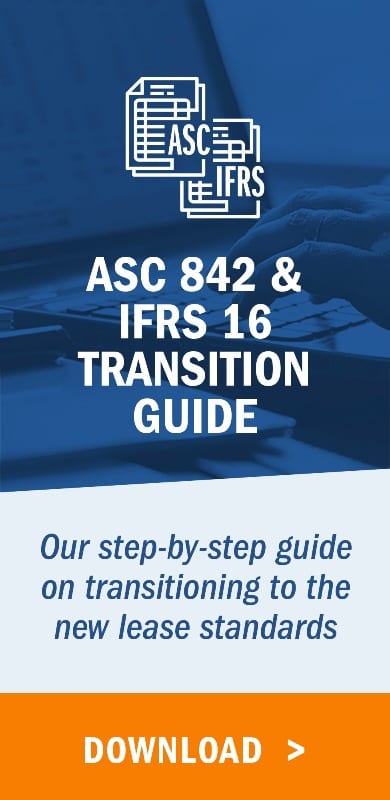When does a lease start for accounting purposes? Is it the execution date? The move-in date? The date the company opens for business at the location? The first date you make payments? In this article we will explore all that and more, under both ASC 840 and ASC 842, the lease accounting standards for US GAAP.
Determining the lease start date and lease term under ASC 840
Under ASC 840, the lease start date for accounting purposes is the date possession is passed from the landlord to the tenant. On that date, the lessee, or tenant, should begin recording straight-line rent expense even if that date is earlier than the “commencement date” specified in the lease. Under ASC 840, the commencement date specified on the lease document has no bearing on the lease start date. However, the commencement date written in the lease is used to determine the discount rate (for capital leases only) and the portion of the capital vs. operating lease classification test which compares useful life of the leased asset to the lease term in total.
Additionally, the commencement date specified on the lease document may be used to determine the lease end date. This is because, most of the time, the “lease term” specified on the lease document “starts” on the commencement date. So, if the commencement date in a lease document is January 1, 2022 and the lease term defined in the document was 24 months from the commencement date, then the lease end date would be December 31, 2023 regardless of when we started accounting for the lease.
Determining the lease start date and lease term under ASC 842
Under ASC 842, the rule is identical – the lease start date for accounting purposes is still the date control of the underlying asset is passed from the landlord to the tenant. As of the possession date, the lessee, or tenant, recognizes a lease liability and a right-of-use (ROU) asset even if possession occurs earlier than the “commencement date” specified on the lease. Under ASC 842, just as under ASC 840, the commencement date specified on the lease document has no bearing on the lease start date.
To determine the lease end date, you simply look at when the lessee no longer has control or physical possession of the asset. For accounting purposes, the lease term and amortization under ASC 842 starts when the lessee takes possession of the asset, and ends on the date when the lessee returns the underlying asset to the lessor or when title transfers to the lessee. As with ASC 840, the lease term may be defined as a specific period after the stated commencement date outlined in the contract.
Unlike ASC 840, ASC 842 specifies the possession date as the date to determine the discount rate for finance (previously capital) and operating leases, and the portion of the finance vs. operating lease classification test, which compares useful life of the leased asset to the lease term in total.
Finding a lease start date in lease document language: Two examples
You’ve probably seen language in a lease as follows:
Lease Term: A term commencing on January 1, 2021 (Commencement Date) and continuing for sixty-six (66) full calendar months. Tenant shall be granted access to the Premises sixty (60) days prior to the Commencement Date to install equipment and furnishings (the “Early Access Period”). Such access shall be subject to all the terms and conditions of this Lease, except that the Commencement Date and the payment of Rent shall not be triggered thereby.
Based on the language above, the lessee should record the lease on November 1, 2020 (or on the date the lessee possesses the asset) under ASC 840, and the lease term is actually 68 months. The 68 month term is the sum of the written lease term of 66 months plus the 2 additional months between November 1, 2020 and December 31, 2020 when the lessee will control the asset. Under ASC 842, the tenant records the initial ROU asset and lease liability value as of November 1, 2020 also and begins accounting for the lease as of that date, even though the contract explicitly asserts a commencement date of January 1, 2021.
Here’s a second example:
The Lease Term shall be for a period of one hundred twenty (120) months commencing one hundred fifty (150) days after the date upon which Tenant opens for business at the Demised Premises (the “Commencement Date”).
In this example, assuming the tenant takes possession of the premises on January 1, 2020 (to construct leasehold improvements) and opens for business on June 1, 2020, the commencement date per the lease document is November 1, 2020. However, for accounting purposes, under both ASC 840 and ASC 842 the lease start date is actually January 1, 2020 (the possession date), and the tenant would have to account for this lease from January through October 2020, even though the lease asserts the commencement date is November 1, 2020 and no cash payment is made until that time. Additionally, the accounting lease term begins January 2020 and is actually 130 months, as opposed to 120 months as stated in the lease.
In all cases, it is critically important to get the lease start date correct for accounting purposes. This start date affects the term over which the lease is accounted for, which changes the periodic straight-line rent expense recognition.
Complications and subjectivity under ASC 842
Multiple assumptions and judgements may need to be made when measuring the initial lease term and valuation under ASC 842. The renewal and termination options of a lease contract affect the lease term and are subject to the lessee’s determination of certainty. Additionally, the length of the lease term has bearing on whether or not the lease is considered short-term at both transition and initial recognition.
Renewal options
Contracts often have clauses which give the tenant an option to renew their lease after the initial rental period is over, much like an apartment lease for an individual. To measure the initial ROU asset and lease liability, the lessee must determine at the start of the lease whether they are reasonably certain to exercise the available renewal options at end-of-term. This is a subjective determination based on many different business factors. If the lessee decides they are reasonably certain to exercise their option(s) to renew, then the renewal period(s) time must also be included in the original lease term for accounting purposes, and the opening ROU asset and lease liability value will increase accordingly.
Termination options
The initial measurement of the lease liability and ROU asset under ASC 842 is also affected by the termination options of the lease. If only the lessee or lessor has the right to terminate a lease agreement without penalty, there is no impact to the lease term. However, when both the lessee and lessor have the right to terminate a lease agreement without penalty, the lease is effectively unenforceable for the periods both parties are able to terminate. In these cases, if the non cancellable period is less than 12 months, the lease is treated like a short-term lease even if the term is indefinite.
Short-term leases
Under ASC 842, any leased asset which the lessee possesses for less than 1 full year (including any renewal options which are reasonably certain to be exercised) does not have to be capitalized. These leases are still considered leases under ASC 842, but there will be no balance sheet impact associated with them; they are treated just as operating leases were under ASC 840, and only accounted for as straight-line expense for the duration of the rental.
Summary
Now you know the difference between the commencement date stated in a lease and the accounting lease start date and how these dates are applied to lessee lease calculations under ASC 840 and ASC 842. As you are comparing reviews and making decisions on your lease accounting software, make sure to ask vendors if their software solutions track both the commencement date as well as the possession date. Also ask if the software begins amortizing the lease liability and ROU asset from the possession date and not the commencement date. LeaseQuery accounting software performs these functions effortlessly.



